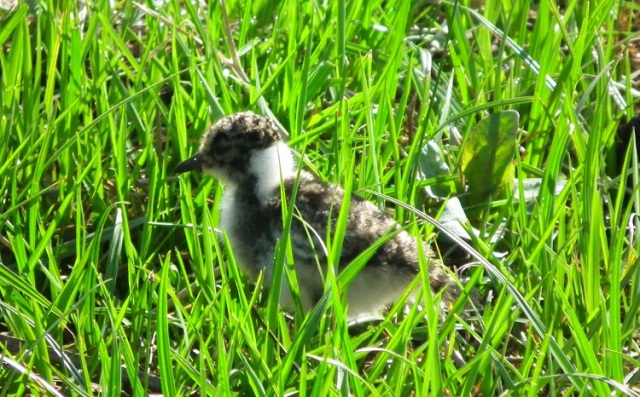The Blacksmith Lapwing or Blacksmith Plover (Vanellus armatus) is named for its repeated metallic ‘tink, tink, tink’ alarm call – which sounds similar to a blacksmith’s hammer striking metal. (bet you didn’t know that !!!! don’t worry neither did I)
The Blacksmith is usually monogamous — being loyal to one partner for the rest of its life, or until the mate dies, at which time it will pursue others. (Did you know that ?? I did)
The nest is a simple scrape in the ground, usually lined with vegetation, stones and mud flakes. The average clutch size consists of 1 to 4 eggs. Both parents incubate the eggs for about 26 to 33 days; typically in shifts of 20 to 80 minutes.
The young leave the nest within hours of hatching but remain close to their parents. They fledge when they are about 40 days old and usually self-sufficient a month later.
Daddy keeping an eye…





Cute little chick 🙂 Pawkiss 🙂
Aren’t they just…
Sjoe, pragtige voësl. Was seker nie te maklik om die kuikens te kon kiek? Ek hou van die manier wat jy hulle ‘alarm call’ beskryf. OUlik.
Ek was gelukkig om hulle te vind in die ope … dankie
That’s such a cute reason for the name. 🙂
Isn’t it just…??
I love those babies, Rob! They’re so cute 😀 I didn’t know they got their name from the blacksmith’s hammer, but I did know they were monogamous. What faithful little creatures they are 😉
I do agree and what brave little fellows they are too… I recall watching, not the blacksmith, but rather the crowned plover turning a huge bull elephant away from its nest … they kept flying directly at the face of the elephant till he turned to get away from them… I suppose it was like a fly is to us when they buzz around ones eyes…
Seems like the animal kingdom is more in to monogamy than a lot of humans 🙂 Their unique markings are very attractive.
Yes I do agree with you on that one… however I hesitated to mention that some are known to go the naughty route and it is thought that it might have something to do with the success of raising the young…
What a treat to capture the fledglings. 🙂
Thanks LuAnn
I was delighted to have a chance to see the fledgelings. We don’t get to see the babies very often! 🙂 What wonderful parents!
They are so good at protecting their young and with the slightest noise they will just disappear into the grass only to appear again when receiving a signal from the parents…
How sweet are those fluffy little babies! Gorgeous photos, Bulldog. 🙂 I would imagine that their nests, being on the ground, are quite vulnerable to predators.
Monkeys and the water monitors are their biggest enemies… and one would think standing on the nest another…. but well before you actually reach the nest these birds are dive bombing you..
Good morning. 🙂
And a good morning to you too
Off to dreamland now. 🙂 Zzzzzzz
And have a good sleep too
I am almost always amazed by how you find these beauties. 🙂
Thank you Imelda… I know where to look for them
I just fell in love! I love birds in general, but the fluffy chicks I admit they drive me crazy!
Thank you… glad you fell in love with these little ones
Oh…so, so sweet….
So fuzzy!!!
So cute! I didn’t know any of these. But reading your posts, monogamy is quite popular among our feathered friends…;)
They are soooo lovely, so lovely 🙂 Thank you dear Rob, have a nice weekend, love, nia
Such cute babies!
Well, I for one, knew none of that – thanks for the wonderful photos and info bulldog!
It was a great pleasure, Diana
Great shots Rob and it’s great to see the little baby up close. Great info as well. 😀
We have lots of them at the dam but don’t dare go near them or their young ones. 😆
This one became a good friend and accept ed my presence without the attacking flight. Thank you Sonel. ..
You have some incredibly pretty birds. Amazing though, the young looks nothing like its adult self – or its parents.
Those young from day one can disappear into the surrounds so easily that it is difficult to believe. … their camouflage is magnificent and they only really begin to colour like adults when they can fly
Wonderful photos, great shot of the nest.
Thanks Charlie
Nice photos once again.
Thanks Anneli
Is it unusual for birds to get used to a visitor’s company and not mind the stranger to get near their nests?
It is unusual… and I’ve not found many in my life time that have. .. this is one and the other was a Bateleur eagle… I write about it in my book how for years I kept returning to its nest to climb the tree and observe the raising of the young…these eagle got to know me and would come down to the nest to watch me watching them… normally they would attack anyone or thing that went near their nest. . This was a privilege to be accepted by birds as one that was not there to harm them, but merely to observe. ..
The chick is so cute and the characteristic lapwing prancing high steps make me smile, fascinating about the tink tink……
Thanks Cindy… I do enjoy this bird, got so attached to this one I had to get her to stand by picking her up to get a photo of the eggs… they got so used to my company they didn’t even attack me when near them….